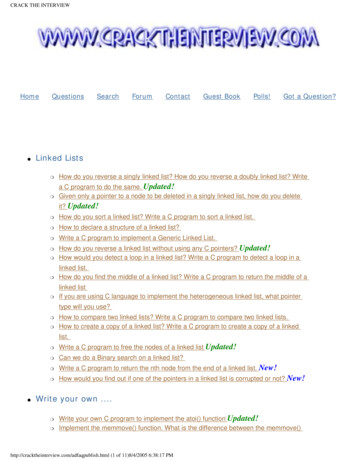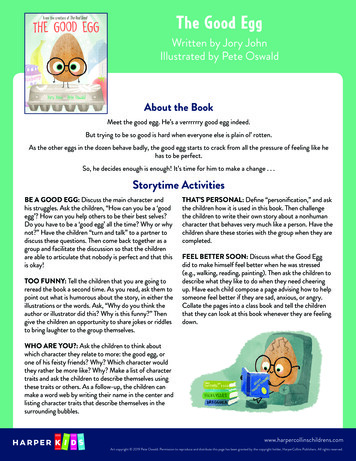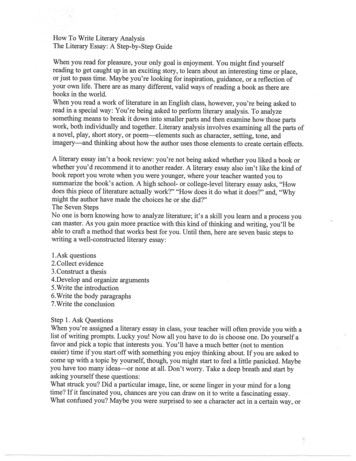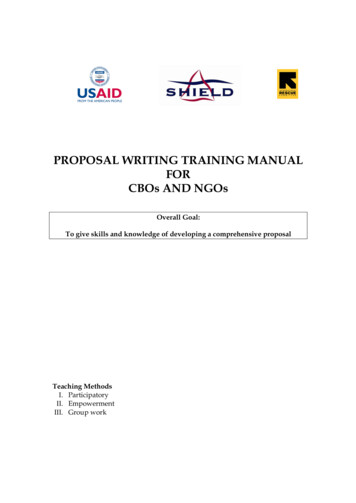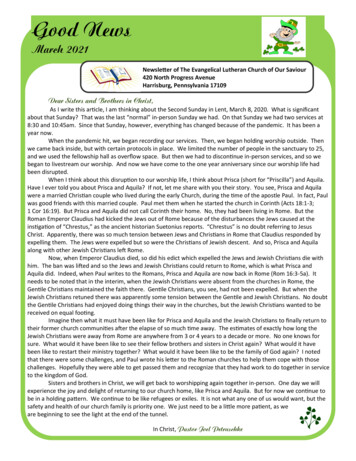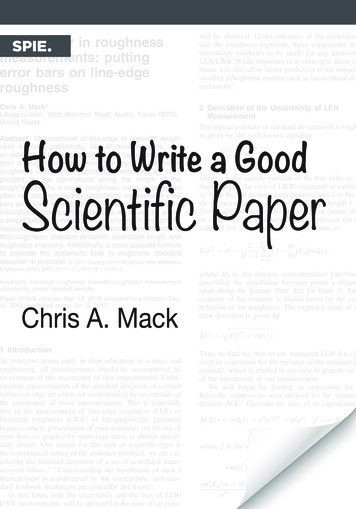
Transcription
How to Write a GoodScientific PaperChris A. Mack
SPIE Terms of Use: This SPIE eBook is DRM-free for your convenience. You may install this eBook on anydevice you own, but not post it publicly or transmit it to others. SPIE eBooks are for personal use only.For details, see the SPIE Terms of Use. To order a print version, visit SPIE.
How to Write a GoodScientific PaperChris A. Mack
Library of Congress Preassigned Control Number: 2017964213forHow to write a good scientific paper (ISBN 9781510619135).Published bySPIEP.O. Box 10Bellingham, Washington 98227-0010 USAPhone: 1 360.676.3290Fax: 1 360.647.1445Email: books@spie.orgWeb: http://spie.orgCopyright 2018 Society of Photo-Optical Instrumentation Engineers (SPIE)All rights reserved. No part of this publication may be reproduced or distributedin any form or by any means without written permission of the publisher.The content of this book reflects the work and thought of the author. Every efforthas been made to publish reliable and accurate information herein, but thepublisher is not responsible for the validity of the information or for anyoutcomes resulting from reliance thereon.Printed in the United States of America.First printing
How to Write a GoodScientific PaperChris A. MackSPIE PRESSBellingham, Washington USA
ContentsPreface . ixChapter 1 Getting Started . 11.1Why Write and Publish a Paper? .11.2The Literature Search.21.3Plan and Execute Research with Publication in Mind .31.4Conclusions .4References .4Chapter 22.12.22.32.42.52.6Structure and Organization . 5The Standard Structure of a Scientific Paper .5Introduction.6Method .7Results and Discussion .8Conclusions.9The Structures of Papers in the Journal of Micro/Nanolithography,MEMS, and MOEMS .92.7Conclusions.10References .10Chapter 3 Language and Style . 113.1Some Books on Style .113.2The Scientific Style.133.2.1 Truth .133.2.2 Presentation .133.2.3 Scene .143.2.4 Cast .143.2.5 Thought and language .153.3Writing in the Scientific Style .153.4Acronyms .163.5Conclusions.18References .18Chapter 44.14.24.34.4Figures and Tables . 19The Goals of Using Figures .19Errors in Graphs .20Graphical Integrity .21A Few Guidelines . 21v
viContents4.5The x-y Scatterplot .244.5.1 The x-y scatterplot in Excel .244.5.2 Other scatterplot examples .274.6Figure Quality from a Production Standpoint .304.7Tables .314.8Example: Figures and Tables in JM3 .314.9Conclusions.32References .34Chapter 5 Citations . 355.1The Five Goals of Citations .355.2The Literature Search.365.3Verify, Verify, Verify . 375.4Other Problems with Citations .375.5More on Self-Citations.385.6Conclusions.40References .40Chapter 6 Abstract and Title . 416.1Writing an Abstract . 416.2Structured Abstracts .426.3Important Additional Thoughts on Abstracts .456.4Titles .466.5Keywords .476.6Conclusions.48References .48Chapter 7 What an Editor Looks For . 497.1Scope.497.2Quality .497.3Novelty .507.4Significance .507.4.1 Measuring significance.517.4.2 In praise of the null result .527.5Conclusions.55References .55Chapter 8 Picking the Right Journal . 578.1The Specialization Spectrum .578.2Reading in the Age of Search Engines .598.3Avoiding the Wrong Journal.608.4Conclusions.61References .62
ContentsviiChapter 9 Cover Letter. 639.1The Purpose of the Cover Letter .639.2A Structured Cover Letter .649.3Conclusions .65Chapter 10 The Editorial Review Process . 6710.1The Goals of Peer Review.6710.2Characteristics of a Well-Done Review .6810.3The Peer-Review Process at JM3 .6910.4Responsibilities .7210.5Criticisms of the Peer-Review Process .7310.6Conclusions .74References .74Chapter 11 Review Articles . 7511.1What is a Review Article? .7511.2The Structure of a Review Article .7611.3What Makes a Review Article “Good”? .7711.4Conclusions.77References .78Chapter 12 The Ethics of Scientific Publication . 7912.1The Primary Ethic of Scientific Publication .7912.2Author Responsibilities before Publication.8012.3Author Responsibilities during the Peer-Review Process .8012.4Author Responsibilities after Publication .8112.5Conclusions .82References .82Chapter 13 Authorship. 8313.1Defining Authorship.8313.2No Guests or Ghosts.8613.3Do Not Forget the Acknowledgments .8713.4Author Order .8713.5Authorship within JM3 .8813.6Conclusions .89References .90Chapter 14 Plagiarism. 9114.1Copying Another’s Ideas.9114.2Copying Another’s Images .9214.3Copying Another’s Words .9214.4Duplicate Publication, or Self-Plagiarism .9314.5Cultural Issues .93
viiiContents14.6Conclusions .94References .95Chapter 15 Double Publication . 9715.1Something Old, Something New.9715.2The Role of Conference Proceedings .9815.3Conclusions .99Chapter 16 Editorial Ethics. 10116.1Editors’ Responsibilities .10116.2Conclusions .103References .103Appendix: A Checklist for Editors, Reviewers, and Authors . 105
PrefaceWriting for peer-reviewed publication is an important part of the careers of manyscientists and engineers. It is also an essential part of the scientific enterprise.Something this important should be done well. However, many scientists andengineers do not consider themselves good writers, so how can the averagescientist write a good scientific paper?The good news is you do not have to be a good writer to write a good sciencepaper, but you do have to be a careful writer. And while the creativity that oftenmarks good science will sometimes spill over into the writing about that science,in general, good science writing does not require creative writing. In particular,writing for a peer-reviewed science or engineering journal requires learning andexecuting a specific formula for presenting scientific work.This book is all about teaching the style and conventions of writing for a peerreviewed science journal. (For the sake of brevity, I will use the word “science” tomean both science and engineering.) Anyone who absorbs the lessons of this bookcan become a better writer. At the least, you can become a good enough writer thatyour readers will judge your work by the quality of the science rather than thequality of the writing.What I know about science writing has come from three separate experiences.First, I have written over 200 papers in my 30 -year career in the semiconductorindustry. Like most authors, I have become a better writer through practice. I havealso spent the last six years as Editor-in-Chief of the Journal ofMicro/Nanolithography, MEMS, and MOEMS (JM3), published by SPIE. Thatexperience has forced me to judge the writing of others and to see the good, thebad, and the ugly of science publishing. Because of this experience, I embarked ona project of studying what makes for good science writing, and I have read manypapers and books by other writers, editors, and historians of science on that topic.Taking advantage of my post as Editor-in-Chief, I started writing a series ofeditorials in JM3 on good science writing (2012–2018). This book is mostly acompilation of those editorials.ix
xPrefaceThe Three Pillars of ScienceScience can be thought of as the combination of three essential things: (1) acommunal collection of knowledge (both facts/data and theories); (2) a method ofevaluating the efficacy of scientific theories by comparing the predictions of thosetheories to observation/experiment; and (3) an attitude of skeptical inquiry and thebelief that all scientific knowledge is provisional and subject to revision whenconfronted with new evidence. (A popular alternativebreakdown of the “norms” of science, emphasizing itssociological nature, is Merton’s “cudos”, firstintroduced in 1942: communalism, universality,disinterestedness, originality, and skepticism.1) Thisbreakdown of science into a body of knowledge, amethod, and an attitude is useful in assessing the“scientific” content of any given behavior. If any oneof these three pillars of science is missing from anactivity, one cannot claim that the activity is scientific.The growth of scientific knowledge ispredominately incremental—we build on past knowledge more often than wedisplace it. Thus, the first pillar of science—a communal collection ofknowledge—requires mechanisms for disseminating and preserving knowledgewithin the scientific community. By far the most important mechanism in use todayis the scientific publication. Although there are many forms of scientificpublication, the most important is the peer-reviewed journal paper. The goal of thisbook is to help authors produce good scientific papers and thus support the goalsof science.Using This BookThis book can be read straight through, which I recommend for early-careerscientists who are relatively new to writing and publishing papers. It can also beused as a reference for specific topics (e.g., how to produce a good figure or writean abstract). Each chapter is purposely short and can be read in isolation for easyreference. The appendix—a checklist for editors, reviewers, and authors—is asummary of the lessons of this book.Throughout this book I will use the words “science” and “scientist” in the mostexpansive way possible to include people and activities generally called“engineering.” Publishing in highly practical engineering fields or highlytheoretical science fields (and every part of the continuum in between) has mostlythe same requirements. Some fields, such as medicine, include additionalimportant requirements, especially related to the use of and reporting on human oranimal subjects. I will not be covering those important topics in this book, but thegeneral lessons here apply even to those more specialized fields.Because of my experience as Editor-in-Chief of JM3, I have intimateknowledge and insider information about this specific journal. Where useful, Ihave included specific information from JM3 to use as examples of the points I
How to Write a Good Science Paperximake in the book. JM3 is probably representative of journals positioned halfwaybetween pure science and pure engineering, and I hope that examples from thisjournal will make the lessons of this book more real.AcknowledgmentsMy learning about science writing leaves me with many debts of gratitude. Theexperience of writing, for me, had been a mostly joyful and satisfying one. I amindebted to the many good authors who I have read and to the many coauthors Ihave been privileged to write with. Less pleasant have been the rejection lettersand difficult reviews that I have received over the years, but I am even moreindebted to these editors and reviewers for their careful and constructive criticismsthat forced me to improve even when I did not want to. I am also grateful for thereaders of my books and articles who have given me feedback and asked mequestions. They have taught me that when a reader does not understand what I havewritten, it is almost always my fault, not theirs.I would also like to thank the volunteer scientists that make up the editorialboard of JM3. Together, we have gone through the sometimes exciting but oftenroutine process of publishing a peer-reviewed science journal issue after issue.Finally, I would like to thank the wonderful staff of SPIE, who not only publishJM3 but are also publishing this book and making it freely available in electronicformat. I have learned a tremendous amount from Eric Pepper and Karolyn Labes,who have coached and mentored me in my role as Editor-in-Chief and havereviewed and improved all of the material in this book. Thanks to John Mays andScott McNeill as well for reviewing the text of this book.I conclude with these oft-repeated words: much of what is good in this book isa consequence of the many people who have helped me over the years, and all ofwhat is bad is due to my own shortcomings.Chris A. MackAustin, TexasJanuary 2018References1R. K. Merton, The Sociology of Science: Theoretical and Empirical Investigations,University of Chicago Press, Chicago, IL (1973).
Chapter 1Getting StartedIf you are thinking about writing a science paper for peer review and publication,what should be your first steps? Ideally, you have thought about the possibility ofwriting and publishing early in your research project because some early planningcan help you avoid problems later. But first, you should ask yourself about yourmotivations for writing a science paper.1.1 Why Write and Publish a Paper?Writing a paper and getting it published in a peer-reviewed journal is hard work,even after the hard work that led to the publishable results. So why do people doit? What motivates authors to go through the writing process, and then the peerreview process, in order to publish their work? There are two kinds of motivations,altruism and self-interest, and most authors have some combination of the two.AltruismPeer-reviewed science publications are the predominant method today fordisseminating and archiving scientific advances (books, conference presentations,and university teaching are other common ways). Science grows and advancesthrough a communal collection of knowledge that is constantly being challenged,revised, and expanded.1,2 Most scientists (and I include engineering in the broadestsense of science) have a strong desire to contribute to the advancement of theirfield, which is often their primary reason for becoming a scientist. Publication isusually the most straightforward way to make such a contribution, and it is thushighly motivating (and satisfying) to most scientists.Self-InterestPublishing can also bring tangible benefits to an author, thus providing a selfinterested motivation for writing and publishing a paper. Publishing may berequired for career advancement and is frequently accompanied by direct orindirect monetary rewards. The familiar “publish or perish” paradigm in academiaadds a proverbial stick to the carrot of career advancement. But even without theseobvious professional motivations, almost all human beings crave recognition fortheir efforts. I know that I am highly motivated by the reward of peer recognition;1
2Chapter 1I am gratified to see my worked used and referenced, and I take pride in publishingin journals that I respect and admire.Balancing Altruism and Self-InterestLet me be clear that I do not view self-interested motivations as inherently bad oreven fundamentally worse than altruistic motivations. Any properly regulated andwell-functioning “marketplace” (to borrow economic parlance) aligns selfinterested and selfless motivations as much as possible. I suspect that every authorhas some combination of these two classes of motivation. The problem comeswhen altruism and self-interest are not balanced. In particular, if self-interestbecomes so strong as to become selfish and swamp the altruistic goal of scientificadvancement, the entire scientific enterprise can suffer.In the academic world, as in the economic world, systems that promote greaterdisparity in “wealth” contribute to unbalanced selfishness. A winner-take-alltournament, where only the scientists with the top-rated papers published in thetop-rated journals have a chance of getting jobs, tenure, grants, and students, willskew motivations towards self-interest. In the business world, rewarding andrecognizing only monetary gain for one’s employer can have the same effect.(Some universities are actively applying both pressures to their professors.) Theresult can be a continuum of sins: lack of motivation for replication experiments,3bias against the null result, increased prevalence of faddish and safe science overcreative exploration, unnecessary feuds over priority, preference for competitionover collaboration,4 lack of transparency and full disclosure, conflicts of interest,double publication, plagiarism, and outright fraud. (Many of these subjects will bediscussed in the following chapters.)With the exception of outright fraud (at least, to my knowledge), the Journalof Micro/Nanolithography, MEMS, and MOEMS (JM3) has seen all of these sinsin manuscripts submitted for publication during my tenure as editor-in-chief. Ihave no idea if any of these imbalances are trending up or down today. I do knowthat the best way to combat imbalanced self-interest is to find ways to constantlyremind yourself of why you became a scientist or engineer in the first place: tomake a positive difference in the world. (Am I being too bold or naïve to make thisassumption about each of you? I do not think so.) If you keep your altruisticmotivations always close and never compromised, the personal benefits can comealong (self-interest “and” altruism, rather than “or”).1.2 The Literature SearchA new research project almost always begins with a literature search—or at leastit should. The goal of the search is to evaluate the state of our communalknowledge on a topic before embarking on a quest of adding to that knowledge.Because science is about either confirming or refuting existing knowledge ordeveloping new knowledge, a thorough understanding of the current state ofcommunal knowledge is essential. Additionally, this literature search will form a
Getting Started3foundation for the five goals of citations (see Chapter 5). Note that a literaturesearch is not about finding relevant papers, it is about reading relevant papers.Unfortunately, literature searches are rarely done as well as they should be.Here are a few hints to improve literature searches: Do the literature search before performing the research, and certainly beforewriting the paper. The next most promising papers to read are often those referenced in therelevant papers you have already found. Look in fields outside your discipline (this often means looking for differentsearch keywords, which one recursively discovers when reading theliterature outside of one’s discipline). While your memory of which previous papers are worth citing is a goodstart, no one ever knows the full scope of the literature in even the smallestof niche fields. Do not rely on your memory alone. When finishing up the manuscript, look for recent publications on thesubject. Often, other researchers are working on similar topics and mayhave published papers that should be read to ensure that your manuscriptcaptures the latest communal knowledge in the field.Starting a literature search always leads to a difficult question: How do you knowwhen to stop? There will always be important papers that you never find. This isthe nature of modern science. Knowing when to quit (or pause) the literature searchand begin the new work is a matter of judgment and experience.1.3 Plan and Execute Research with Publication in MindMost projects begin with the intention of writing a paper as an output of the work,or at least with the thought that this could be a possibility. If so, the research shouldbe planned and executed with publication in mind. As discussed throughout thisbook (especially in Chapter 2), one of the critical requirements of a science paperis to document the work in sufficient detail so that the reader can follow thereasoning presented and validate the conclusions drawn. Furthermore, the authorsof a published paper must be willing to defend the work against criticism, and sothey should have available for later review the raw data used and significant detailabout the experimental procedure.First and foremost, these goals require good laboratory record keeping.Classically, it is the “lab notebook” that has served this purpose, though today it isoften a virtual notebook of (ideally) well-organized digital files. Knowing whatyou might need from these records for paper writing can help your record keeping.For example, if you review the requirements for what is needed in a method sectionof a paper (see Chapter 2), you will know what record keeping is required to makethe process of writing the methods section easier.
4Chapter 1Raw data are often manipulated, reformatted, filtered, summarized, andgraphed before being presented in a publication. It is almost always a requirementthat the data be archived at each of these various stages. You do not want to be ina position of publishing a graph where the “picture” of the graph is the only thingthat remains of the original data.1.4 ConclusionsExperienced authors have a clear idea of what is required to write a good sciencepaper, and so they plan and execute a research project with the requirements ofpublication in mind. For those with less experience, I recommend reading this book(especially Chapters 2, 7, and 12) at the beginning of a research project to makesure you can meet the most important requirements of writing and publishing yourwork.References1R. K. Merton, The Sociology of Science: Theoretical and Empirical Investigations,University of Chicago Press, Chicago, IL (1973).2T. S. Kuhn, The Structure of Scientific Revolutions, 3rd ed., University of Chicago Press,Chicago, IL (1996).3Editorial, “Go forth and replicate!”, Nature 536, 373 (2016).4F. C. Fang and A. Casadevall, “Competitive Science: Is Competition Ruining Science?”,Infection and Immunity 83(4), 1229 (2015).
Chapter 2Structure and OrganizationWriting is inherently a creative process. That would seem a good fit for the scienceresearcher, where creativity coupled with critical thinking is the key to success.Alas, many scientists do not think of themselves as qualified writers, finding thetask of writing both intimidating and arduous. For those readers who are notalready experienced at writing articles for s
Using This Book This book can be read straight through, which I recommend for early-career scientists who are relatively new to writing and publishing papers. It can also be used as a reference for specific topics (e.g., how to produce a good figure or write an abstract). Each chapter
